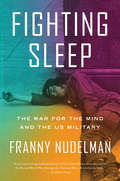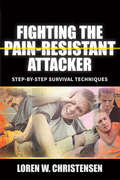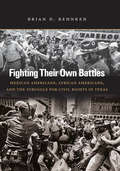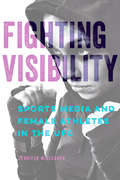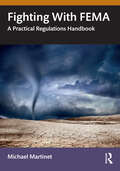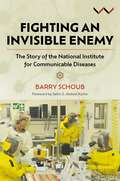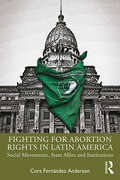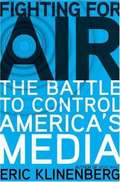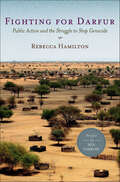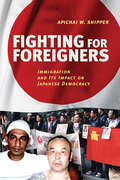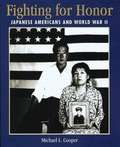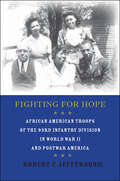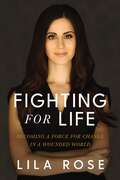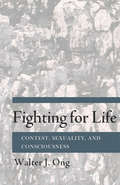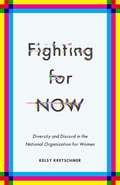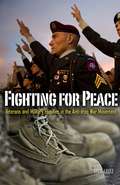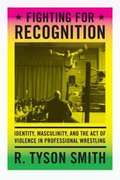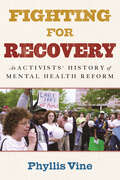- Table View
- List View
Fighting Sleep: The War for the Mind and the US Military
by Franny NudelmanHow the military used sleep as a weapon—and how soldiers fought backOn April 21, 1971, hundreds of Vietnam veterans fell asleep on the National Mall, wondering whether they would be arrested by daybreak. Veterans had fought the courts for the right to sleep in public while demonstrating against the war. When the Supreme Court denied their petition, they decided to break the law and turned sleep into a form of direct action. During and after the Second World War, military psychiatrists used sleep therapies to treat an epidemic of “combat fatigue.” Inducing deep and twilight sleep in clinical settings, they studied the effects of war violence on the mind and developed the techniques of brainwashing that would weaponize both memory and sleep. In the Vietnam War era, radical veterans reclaimed the authority to interpret their own traumatic symptoms—nightmares, flashbacks, insomnia—and pioneered new methods of protest. In Fighting Sleep, Franny Nudelman recounts the struggle over sleep in the postwar world, revealing that sleep was instrumental to the development of military science, professional psychiatry, and antiwar activism. Traversing the fields of military and mainstream psychiatry, popular and institutional film, documentary sound technology, brain warfare, and postwar social movements, she demonstrates that sleep—far from being passive, empty, or null—is a site of contention and a source of political agency.
Fighting The Pain Resistant Attacker: Step-by-Step Survival Techniques
by Loren W. ChristensenStep-by-step survival techniquesThere is a truth in the world of hand-to-hand combat that too many martial artists aren't aware of or refuse to believe. Every time you discover a sure technique, one that makes all your training partners groan and writhe in agony, there exists out there in the mean streets a host of people who won't feel it. People like these:* Attackers with large muscle bulk or large fat bulk* Attackers intoxicated on alcohol* Attackers under the influence of drugs* Attackers out of control with rage* Attackers who are mentally deranged* Attackers who feel pain but like itLoren W. Christensen draws on decades of martial arts training and law enforcement experience, giving you techniques to survive the worst-case scenario.This book isn't about working out with a training partner. It's about surviving a desperate street attack against a nightmare adversary who doesn't acknowledge what you thought was your best shot.
Fighting Their Own Battles: Mexican Americans, African Americans, and the Struggle for Civil Rights in Texas
by Brian D. BehnkenBetween 1940 and 1975, Mexican Americans and African Americans in Texas fought a number of battles in court, at the ballot box, in schools, and on the streets to eliminate segregation and state-imposed racism. Although both groups engaged in civil rights struggles as victims of similar forms of racism and discrimination, they were rarely unified. In Fighting Their Own Battles, Brian Behnken explores the cultural dissimilarities, geographical distance, class tensions, and organizational differences that all worked to separate Mexican Americans and blacks. Behnken further demonstrates that prejudices on both sides undermined the potential for a united civil rights campaign. Coalition building and cooperative civil rights efforts foundered on the rocks of perceived difference, competition, distrust, and, oftentimes, outright racism. Behnken's in-depth study reveals the major issues of contention for the two groups, their different strategies to win rights, and significant thematic developments within the two civil rights struggles. By comparing the histories of these movements in one of the few states in the nation to witness two civil rights movements, Behnken bridges the fields of Mexican American and African American history, revealing the myriad causes that ultimately led these groups to "fight their own battles. "
Fighting Toxic Ignorance: Origins of the Right to Know about Workplace Health Hazards
by Alan DericksonFighting Toxic Ignorance explores conflict over access to information regarding health hazards encountered in the US workplace during the first three-quarters of the twentieth century. Alan Derickson considers risks posed by toxic chemicals and physical and biological agents of disease. By the 1970s, occupational disease was estimated to kill up to 100,000 Americans a year. Derickson unravels the social and political forces and the conflictual process that gave rise to a sustained social movement for a workers' right to know about often-insidious threats. He argues that the decades prior to the emergence of this movement were not a dark age of victimization brought about by enforced ignorance but a time of recurrent battles over the disclosure of needed facts. Workplace warnings—informative signs, labels, and instructions—often saved lives. Fighting Toxic Ignorance covers a broad range of dangerous substances, deals with a large share of the national workforce, and illuminates the many ways that activists endeavored to see that warnings reached workers, especially immigrants and workers of color.
Fighting Traffic: The Dawn of the Motor Age in the American City (Inside Technology)
by Peter D. NortonThe fight for the future of the city street between pedestrians, street railways, and promoters of the automobile between 1915 and 1930.Before the advent of the automobile, users of city streets were diverse and included children at play and pedestrians at large. By 1930, most streets were primarily a motor thoroughfares where children did not belong and where pedestrians were condemned as “jaywalkers.” In Fighting Traffic, Peter Norton argues that to accommodate automobiles, the American city required not only a physical change but also a social one: before the city could be reconstructed for the sake of motorists, its streets had to be socially reconstructed as places where motorists belonged. It was not an evolution, he writes, but a bloody and sometimes violent revolution. Norton describes how street users struggled to define and redefine what streets were for. He examines developments in the crucial transitional years from the 1910s to the 1930s, uncovering a broad anti-automobile campaign that reviled motorists as “road hogs” or “speed demons” and cars as “juggernauts” or “death cars.” He considers the perspectives of all users—pedestrians, police (who had to become “traffic cops”), street railways, downtown businesses, traffic engineers (who often saw cars as the problem, not the solution), and automobile promoters. He finds that pedestrians and parents campaigned in moral terms, fighting for “justice.” Cities and downtown businesses tried to regulate traffic in the name of “efficiency.” Automotive interest groups, meanwhile, legitimized their claim to the streets by invoking “freedom”—a rhetorical stance of particular power in the United States. Fighting Traffic offers a new look at both the origins of the automotive city in America and how social groups shape technological change.
Fighting Visibility: Sports Media and Female Athletes in the UFC (Studies in Sports Media #1)
by Jennifer McClearenUltimate Fighting Championship and the present and future of women's sports Mixed martial arts stars like Amanda Nunes, Zhang Weili, and Ronda Rousey have made female athletes top draws in the Ultimate Fighting Championship (UFC). Jennifer McClearen charts how the promotion incorporates women into its far-flung media ventures and investigates the complexities surrounding female inclusion. On the one hand, the undeniable popularity of cards headlined by women add much-needed diversity to the sporting landscape. On the other, the UFC leverages an illusion of promoting difference—whether gender, racial, ethnic, or sexual—to grow its empire with an inexpensive and expendable pool of female fighters. McClearen illuminates how the UFC's half-hearted efforts at representation generate profit and cultural cachet while covering up the fact it exploits women of color, lesbians, gender non-conforming women, and others. Thought provoking and timely, Fighting Visibility tells the story of how a sports entertainment phenomenon made difference a part of its brand—and the ways women paid the price for success.
Fighting With FEMA: A Practical Regulations Handbook
by Michael MartinetIn this book, disaster finance and cost recovery expert Michael Martinet provides unparalleled coverage of the practical, real-world key principles necessary to successfully navigate the nuances of federal regulations surrounding FEMA’s Public Assistance program. Accessibly written, Martinet demystifies the many policies, procedures, and administrative processes a local government agency should adopt before a disaster to prepare themselves for a greater financial recovery after a disaster. The intent is to awaken local authorities to the realities of the process and assist them in preparing for a day which all hope they will never see.Designed for financial officers, purchasing officials, Public Works officials, Building & Safety officials, public construction project managers, and emergency management professionals at all levels of government, Fighting With FEMA will also earn a place in the libraries of consulting disaster recovery specialists and students interested in the financial aspects of disasters.
Fighting Words: Black Women And The Search For Justice (Contradictions Of Modernity Series #Volume Seven)
by Patricia Hill CollinsA professor of sociology explores how black feminist thought confronts the injustices of poverty and white supremacy, and argues that those operating outside the mainstream emphasize sociological themes based on assumptions different than those commonly accepted.
Fighting an Invisible Enemy: The Story of the National Institute for Communicable Diseases
by Barry SchoubFighting an Invisible Enemy narrates the founding in 2002 and growth of the internationally renowned centre of excellence for communicable diseases, the National Institute for Communicable Diseases (NICD) in South Africa. In a continent riven with a panoply of formidable contagious pathogens, the book describes how the nascent NICD travelled a rocky road to maturity. Starting humbly, as did many of its sister public health institutions around the world, the road was strewn with daunting obstacles of financial restrictions, bureaucratic straitjacketing, international isolation during the apartheid era and, in later years, the calumny of governmental AIDS denial. Following the triumph of the eradication of the once-dreaded smallpox, the NICD now plays a crucial role in the global effort to eradicate poliomyelitis. While the country has the misfortune of the largest HIV/AIDS pandemic in the world, the Institute’s HIV research unit has become a world leader. More remote from public notice are the laboratories and support epidemiologists carry out for ongoing surveillance of communicable diseases and the alerts they provide for any signal of an impending outbreak or pandemic. The Institute’s value to public health was clearly shown in the recent Covid-19 pandemic. The maxim that we are only safe when everyone everywhere is safe, underlines the importance of international partnerships and the key role the NICD plays, not only for the country but also for global health. This is a flagship organisation in public health in South Africa and this book paints a vivid portrait of its incredible accomplishments.
Fighting for Abortion Rights in Latin America: Social Movements, State Allies and Institutions
by Cora Fernández AndersonAlthough they share similar socio-economic and cultural characteristics as well as their recent political histories, Argentina, Chile and Uruguay differ radically in their abortion policies. In this book, Cora Fernández Anderson examines the role social movements play in abortion reform to show how different interaction patterns with state actors have led to three different policy outcomes: comprehensive abortion reform in Uruguay; moderate abortion reform in Chile; and no legal abortion reform in Argentina. Synthesizing a broad range of literature and drawing on in-depth field and archival research, she analyzes the strength of the campaigns for abortion reform, their relationships with leftist parties in power and the context of Church–state relations to explain this diverging trajectory in policy reform. A masterly analysis of how social movements, the power of institutions and Executive preferences have strong explanatory power, Fighting for Abortion Rights in Latin America is a perfect supplement for classes on gender and global politics.
Fighting for Air: The Battle to Control America's Media
by Eric KlinenbergA groundbreaking investigative work by a critically acclaimed sociologist on the corporate takeover of local news and what it means for all Americans For the residents of Minot, North Dakota, Clear Channel Communications is synonymous with disaster. Early in the morning of January 18, 2002, a train derailment sent a cloud of poisonous gas drifting toward the small town. Minot's fire and rescue departments attempted to reach Clear Channel, which owned and operated all six local commercial radio stations, to warn residents of the approaching threat. But in the age of canned programming and virtual DJs, there was no one in the conglomerate's studio to take the call. The people of Minot were taken unawares. The result: one death and more than a thousand injuries. Opening with the story of the Minot tragedy, Eric Klinenberg's "Fighting for Air" takes us into the world of pre-programmed radio shows, empty television news stations, and copycat newspapers to show how corporate ownership and control of local media has remade American political and cultural life. Klinenberg argues that the demise of truly local media stems from the federal government's malign neglect, as the agencies charged with ensuring diversity and open competition have ceded control to the very conglomerates that consistently undermine these values and goals. Such "big media" may not be here to stay, however. "Fighting for Air" delivers a call to action, revealing a rising generation of new media activists and citizen journalists-- a coalition of liberals and conservatives-- who are demanding and even creating the local coverage they need and deserve.
Fighting for Citizenship: Black Northerners and the Debate over Military Service in the Civil War (Civil War America)
by Brian TaylorIn Fighting for Citizenship, Brian Taylor complicates existing interpretations of why black men fought in the Civil War. Civil War–era African Americans recognized the urgency of a core political concern: how best to use the opportunity presented by this conflict over slavery to win abolition and secure enduring black rights, goals that had eluded earlier generations of black veterans. Some, like Frederick Douglass, urged immediate enlistment to support the cause of emancipation, hoping that a Northern victory would bring about the end of slavery. But others counseled patience and negotiation, drawing on a historical memory of unfulfilled promises for black military service in previous American wars and encouraging black men to leverage their position to demand abolition and equal citizenship. In doing this, they also began redefining what it meant to be a black man who fights for the United States.These debates over African Americans' enlistment expose a formative moment in the development of American citizenship: black Northerners' key demand was that military service earn full American citizenship, a term that had no precise definition prior to the Fourteenth Amendment. In articulating this demand, Taylor argues, black Northerners participated in the remaking of American citizenship itself—unquestionably one of the war's most important results.
Fighting for Darfur: Public Action and the Struggle to Stop Genocide
by Rebecca HamiltonAround the world, millions of people have added their voices to protest marches and demonstrations because they believe that, together, they can make a difference. When we failed to stop the genocide in Rwanda in 1994, we promised to never let such a thing happen again. But nine years later, as news began to trickle out of killings in western Sudan, an area known as Darfur, the international community again faced the problem of how the United Nations and the United States government could respond to mass atrocity.Rebecca Hamilton passionately narrates the six-year grassroots campaign to draw global attention to the plight of Darfur's people. From college students who galvanized entire university campuses in the belief that their outcry could save millions of Darfuris still at risk, to celebrities such as Mia Farrow, who spurred politicians to act, to Steven Spielberg, who boycotted the 2008 Summer Olympics in Beijing, Hamilton details how advocacy for Darfur was an exuberant, multibillion-dollar effort. She then does what no one has done to date: she takes us into the corridors of power and the camps of Darfur, and reveals the impact of ordinary people's fierce determination to uphold the mantra of "never again." Fighting for Darfur weaves a gripping story that both dramatizes our moral dilemma and shows the promise and perils of citizen engagement in a new era of global compassion.
Fighting for Dignity: Migrant Lives at Israel's Margins (Contemporary Ethnography)
by Sarah S. WillenIn Fighting for Dignity, Sarah S. Willen explores what happened when the Israeli government launched an aggressive deportation campaign targeting newly arrived migrants from countries as varied as Ghana and the Philippines, Nigeria, Colombia, and Ukraine. Although the campaign was billed as a solution to high unemployment, it had another goal as well: to promote an exclusionary vision of Israel as a Jewish state in which non-Jews have no place. The deportation campaign quickly devastated Tel Aviv's migrant communities and set the stage for even more aggressive antimigrant and antirefugee policies in the years to come.Fighting for Dignity traces the roots of this deportation campaign in Israeli history and the Israeli-Palestinian conflict and shows how policies that illegalize and criminalize migrants wreak havoc in their lives, endanger their health, and curtail the human capacity to flourish. Children born to migrant parents are especially vulnerable to developmental and psychosocial risks. Drawing on nearly two decades of ethnographic engagement in homes and in churches, medical offices, advocacy organizations, and public spaces, Willen shows how migrants struggle to craft meaningful, flourishing lives despite the exclusions and vulnerabilities they endure. To complement their perspectives, she introduces Israeli activists who reject their government's exclusionary agenda and strive to build bridges across difference, repair violations of migrants' dignity, and resist policies that violate their own moral convictions. Willen's vivid and unflinching ethnography challenges us to reconsider our understandings of global migration, human rights, the Middle East— and even dignity itself.
Fighting for Foreigners: Immigration and Its Impact on Japanese Democracy
by Apichai W. ShipperAlthough stereotypically homogenized and hostile to immigrants, Japan has experienced an influx of foreigners from Asia and Latin America in recent decades. In Fighting for Foreigners, Apichai W. Shipper details how, in response, Japanese citizens have established a variety of local advocacy groups-some faith based, some secular-to help immigrants secure access to social services, economic equity, and political rights.Drawing on his years of ethnographic fieldwork and a pragmatic account of political motivation he calls associative activism, Shipper asserts that institutions that support illegal foreigners make the most dramatic contributions to democratic multiculturalism. The changing demographics of Japan have been stimulating public discussions, the political participation of marginalized groups, and calls for fair treatment of immigrants. Nongovernmental organizations established by the Japanese have been more effective than the ethnically particular associations formed by migrants themselves, Shipper finds. Activists who initially work in concert to solve specific and local problems eventually become more ambitious in terms of political representation and opinion formation.As debates about the costs and benefits of immigration rage across the developed world, Shipper's research offers a refreshing new perspective: rather than undermining democracy in industrialized society, immigrants can make a positive institutional contribution to vibrant forms of democratic multiculturalism.
Fighting for Girls: New Perspectives on Gender and Violence (SUNY series in Women, Crime, and Criminology)
by Meda Chesney-Lind Nikki JonesHave girls really gone wild? Despite the media fascination with "bad girls," facts beyond the hype have remained unclear. Fighting for Girls focuses on these facts, and using the best data availabe about actual trends in girls' uses of violence, the scholars here find that by virtually any measure available, incidents of girls' violence are going down, not up. Additionally, rather than attributing girls violence to personality or to girls becoming "more like boys," Fighting for Girls focuses on the contexts that produce violence in girls, demonstrating how addressing the unique problems that confront girls in dating relationships, families, school hallways and classrooms, and in distressed urban neighborhoods can help reduce girls' use of violence. Often including girls' own voices, contributors to the volume illustrate why girls use violence in certain situations, encouraging us to pay attention to trauma in the girls' pasts as well as how violence becomes a tool girls use to survive toxic families, deteriorated neighborhoods, and neglectful schools.
Fighting for Honor: Japanese Americans and World War II
by Michael L. CooperAn account of Japanese Americans in World War II, based mainly on diaries, autobiographies, and the military records of the 442nd Regimental Combat Team, which was known as the Purple Heart Battalion because of its bravery. After the attack on Pearl Harbor in 1941, all people on the West Coast of Japanese heritage, whether resident aliens or citizens, were forced to move into internment camps. But 1,200 young men from the camps, along with 10,000 other GIs of Japanese heritage, became some of the most decorated soldiers in the war as part of the 442nd. Author Michel L. Cooper tells of the remarkable bravery of these Nisei soldiers, whose heroism in battles in Europe contrasted with the prejudice that Japanese Americans faced at home.
Fighting for Hope: African American Troops of the 93rd Infantry Division in World War II and Postwar America (War, Society, Culture Ser.)
by Robert F. Jefferson“A rigorously researched, richly etched re-creation of the formation of the all-black Ninety-third Infantry Division, which fought in the Pacific theater.” —Journal of American HistoryThis fascinating history shows how African-American military men and women seized their dignity through barracks culture and community politics during and after World War II.Drawing on oral testimony, unpublished correspondence, archival records, memoirs, and diaries, Robert F. Jefferson explores the curious contradiction of war-effort idealism and entrenched discrimination through the experiences of the 93rd Infantry Division. Led by white officers and presumably unable to fight—and with the army taking great pains to regulate contact between black soldiers and local women—the division was largely relegated to support roles during the advance on the Philippines, seeing action only later in the war when U.S. officials found it unavoidable.Jefferson discusses racial policy within the War Department, examines the lives and morale of black GIs and their families, documents the debate over the deployment of black troops, and focuses on how the soldiers’ wartime experiences reshaped their perspectives on race and citizenship in America. He finds in these men and their families incredible resilience in the face of racism at war and at home and shows how their hopes for the future provided a blueprint for America’s postwar civil rights struggles.Integrating social history and civil rights movement studies, Fighting for Hope examines the ways in which political meaning and identity were reflected in the aspirations of these black GIs and their role in transforming the face of America.“A marvelous book.” —Annals of Iowa
Fighting for Hope: African American Troops of the 93rd Infantry Division in World War II and Postwar America (War/Society/Culture)
by Robert F. JeffersonThis fascinating history shows how African-American military men and women seized their dignity through barracks culture and community politics during and after World War II.Drawing on oral testimony, unpublished correspondence, archival records, memoirs, and diaries, Robert F. Jefferson explores the curious contradiction of war-effort idealism and entrenched discrimination through the experiences of the 93rd Infantry Division. Led by white officers and presumably unable to fight—and with the army taking great pains to regulate contact between black soldiers and local women—the division was largely relegated to support roles during the advance on the Philippines, seeing action only later in the war when U.S. officials found it unavoidable. Jefferson discusses racial policy within the War Department, examines the lives and morale of black GIs and their families, documents the debate over the deployment of black troops, and focuses on how the soldiers’ wartime experiences reshaped their perspectives on race and citizenship in America. He finds in these men and their families incredible resilience in the face of racism at war and at home and shows how their hopes for the future provided a blueprint for America’s postwar civil rights struggles.Integrating social history and civil rights movement studies, Fighting for Hope examines the ways in which political meaning and identity were reflected in the aspirations of these black GIs and their role in transforming the face of America.
Fighting for Life: Becoming a Force for Change in a Wounded World
by Lila RoseWhat makes your heart break for our broken world? You want to make a difference in the world. You&’re concerned about all the problems you see, the injustices and the suffering. But you don&’t know where to begin. Designed for the aspiring activist or world-changer, this book is the key to get you started.Live Action founder Lila Rose says transformation begins with heartbreak—with seeing the injustices around you and allowing that suffering to light a fire in your soul. In this book, she shares raw and intimate stories from both her personal journey and pro-life activism that will inspire you to become a champion for your own cause. Along the way, you&’ll discover how todetermine where the need for your gifts is the greatest and begin making a difference;overcome insecurities and imposter syndrome and become a leader through practice;find inner courage and confidence in the face of obstacles and criticism; andbounce back from mistakes to continually grow and make a long-lasting impact.The fight for a world that is more just, more beautiful, and more loving needs all of us. In allowing yourself to be wounded by the brokenness of our world, you&’ll find the passion you need to make a difference—and draw closer to the One who truly saves.
Fighting for Life: Contest, Sexuality, and Consciousness
by Walter J. OngWhat accounts for the continued popularity of the macho image, the fanaticism of sports enthusiasts, the perennial appeal of Don Quixote's ineffectual struggles? Walter J. Ong addresses these and related questions as he offers new insights into the complex ways in which human life is affected by contest. Ong argues that the struggle for dominance, which he feels is crucial among higher animal species, is more immediately critical for males than for females, helping males to manage persistent insecurity and to establish sexual identity. The male agonistic drive finds an outlet in contests as diverse as football, cockfighting, and chess--the last, the ultimate intellectualization of formalized territorial combat. Demonstrating the importance of contest in biological evolution and in the growth of consciousness out of the unconscious, Ong shows how adversarial today's shifting patterns of contest in such arenas as spectator sports, politics, business, religion, academe, and the history of rhetoric. Human internalization of agonistic drives, he concludes, can foster the deeper discovery of the self and of distinctively human freedom.
Fighting for NOW: Diversity and Discord in the National Organization for Women
by Kelsy KretschmerAn unparalleled exploration of NOW’s trajectory, from its founding to the present—and its future A new wave of feminist energy has swept the globe since 2016—from women’s marches and the #MeToo movement to transwomen’s inclusion and exclusion in feminism and participation in institutional politics. Amid all this, an organization declared dead or dying for thirty years—the National Organization for Women—has seen a membership boom. NOW presents an intriguing puzzle for scholars and activists alike. Considered one of the most stable organizations in the feminist movement, it has experienced much conflict and schism. Scholars have long argued that factionalism is the death knell of organizations, yet NOW continues to thrive despite internal conflicts. Fighting for NOW seeks to better understand how bureaucratic structures like NOW’s simultaneously provide stability and longevity, while creating space for productive and healthy conflict among members. Kelsy Kretschmer explores these ideas through an examination of conflict in NOW’s local chapters, its task forces and committees, and its satellite groups. NOW’s history provides evidence for three basic arguments: bureaucratic groups are not insulated from factionalism; they are important sites of creativity and innovation for their movements; and schisms are not inherently bad for movement organizations. Hence, Fighting for NOW is in stark contrast to conventional scholarship, which has conceptualized factionalism as organizational failure. It also provides one of the few book-length explorations of NOW’s trajectory, from its founding to the modern context. Scholars will welcome the book’s insights that draw on open systems and resource dependency theories, as well as its rethinking of how conflict shapes activist communities. Students will welcome its clear and compelling history of the feminist movement and of how feminist ideas have changed over the past five decades.
Fighting for Peace: Veterans and Military Families in the Anti–Iraq War Movement (Social Movements, Protest and Contention #40)
by Lisa LeitzFighting for Peace brings to light an important yet neglected aspect of opposition to the Iraq War—the role of veterans and their families. Drawing on extensive participant observation and interviews, Lisa Leitz demonstrates how the harrowing war experiences of veterans and their families motivated a significant number of them to engage in peace activism. Married to a Navy pilot herself, Leitz documents how military peace activists created a movement that allowed them to merge two seemingly contradictory sides of their lives: an intimate relation to the military and antiwar activism. Members of the movement strategically deployed their combined military–peace activist identities to attract media attention, assert their authority about the military and war, and challenge dominant pro-war sentiment. By emphasizing the human costs of war, activists hoped to mobilize American citizens and leaders who were detached from the wars in Iraq and Afghanistan, bring the wars to an end, and build up programs to take care of returning veterans and their families. The stories in Fighting for Peace ultimately reveal that America&’s all-volunteer force is contributing to a civilian–military divide that leaves civilians with little connection to the sacrifices of the military. Increasingly, Leitz shows, veterans and their families are being left to not only fight America&’s wars but also to fight against them.
Fighting for Recognition: Identity, Masculinity, and the Act of Violence in Professional Wrestling
by R. Tyson SmithIn Fighting for Recognition, R. Tyson Smith enters the world of independent professional wrestling, a community-based entertainment staged in community centers, high school gyms, and other modest venues. Like the big-name, televised pro wrestlers who originally inspired them, indie wrestlers engage in choreographed fights in character. Smith details the experiences, meanings, and motivations of the young men who wrestle as "Lethal" or "Southern Bad Boy," despite receiving little to no pay and risking the possibility of serious and sometimes permanent injury. Exploring intertwined issues of gender, class, violence, and the body, he sheds new light on the changing sources of identity in a postindustrial society that increasingly features low wages, insecure employment, and fragmented social support. Smith uncovers the tensions between strength and vulnerability, pain and solidarity, and homophobia and homoeroticism that play out both backstage and in the ring as the wrestlers seek recognition from fellow performers and devoted fans.
Fighting for Recovery: An Activists' History of Mental Health Reform
by Phyllis VineAn essential history of the recovery movement for people with mental illness, and an inspiring account of how former patients and advocates challenged a flawed system and encouraged mental health activismThis definitive people&’s history of the recovery movement spans the 1970s to the present day and proves to readers just how essential mental health activism is to every person in this country, whether you have a current psychiatric diagnosis or not.In Fighting for Recovery, professor and mental health advocate Phyllis Vine tells the history of the former psychiatric patients, families, and courageous activists who formed a patients&’ liberation movement that challenged medical authority and proved to the world that recovery from mental illness is possible.Mental health discussions have become more common in everyday life, but there are still enormous numbers of people with psychiatric illness in jails and prisons or who are experiencing homelessness—proving there is still progress to be made.This is a book for youA friend or family member of someone with serious psychiatric diagnoses, to understand the history of mental health reformA person struggling with their own diagnoses, to learn how other patients have advocated for themselvesAn activist in the peer-services network: social workers, psychologists, and peer counselors, to advocate for change in the treatment of psychiatric patients at the institutional and individual levelsA policy maker, clinical psychologist, psychiatric resident, or scholar who wants to become familiar with the social histories of mental illness
